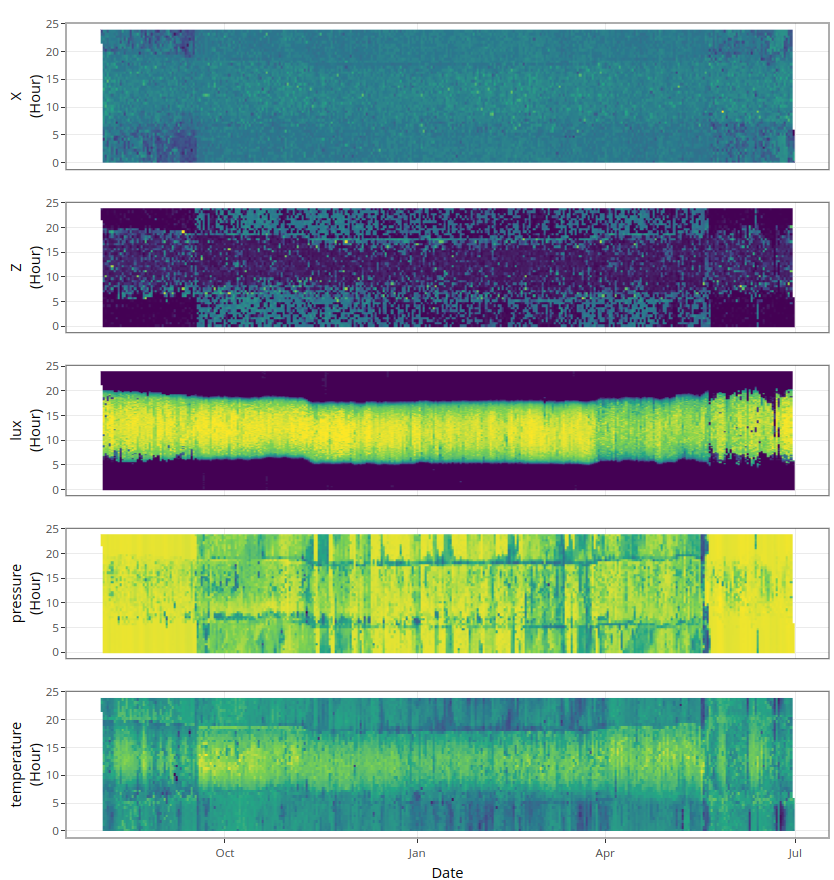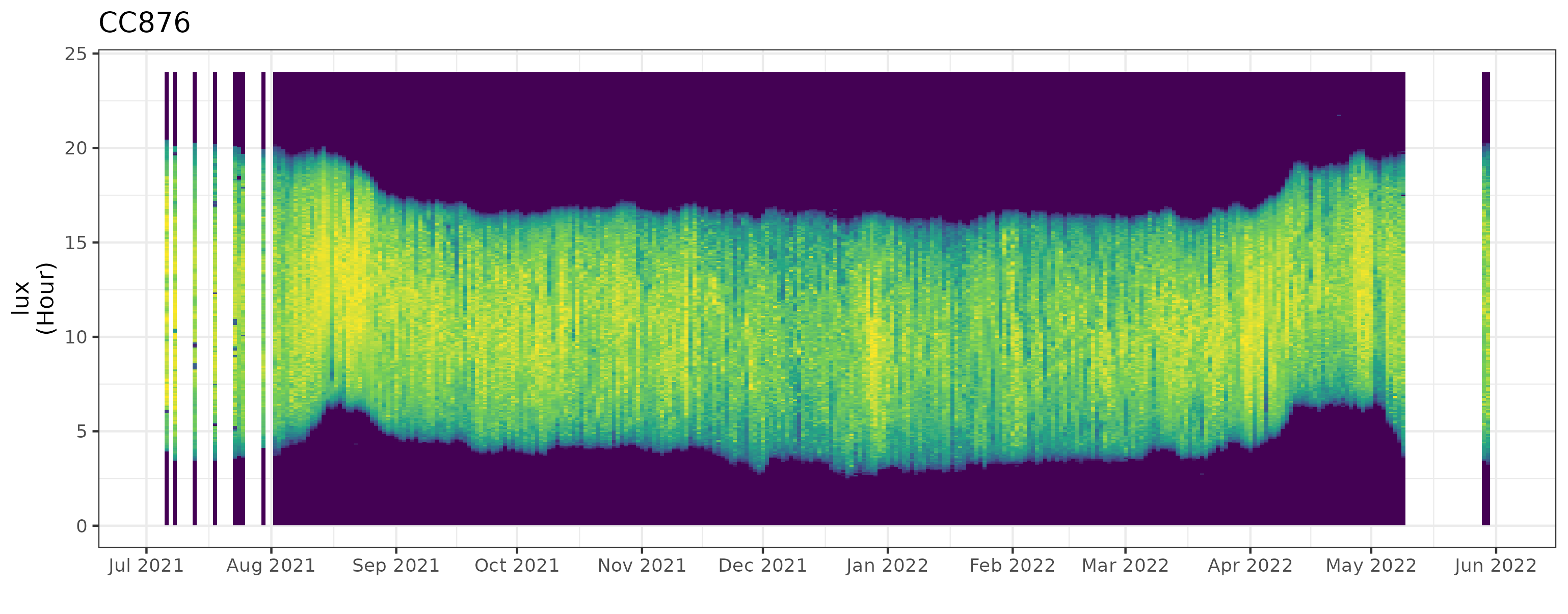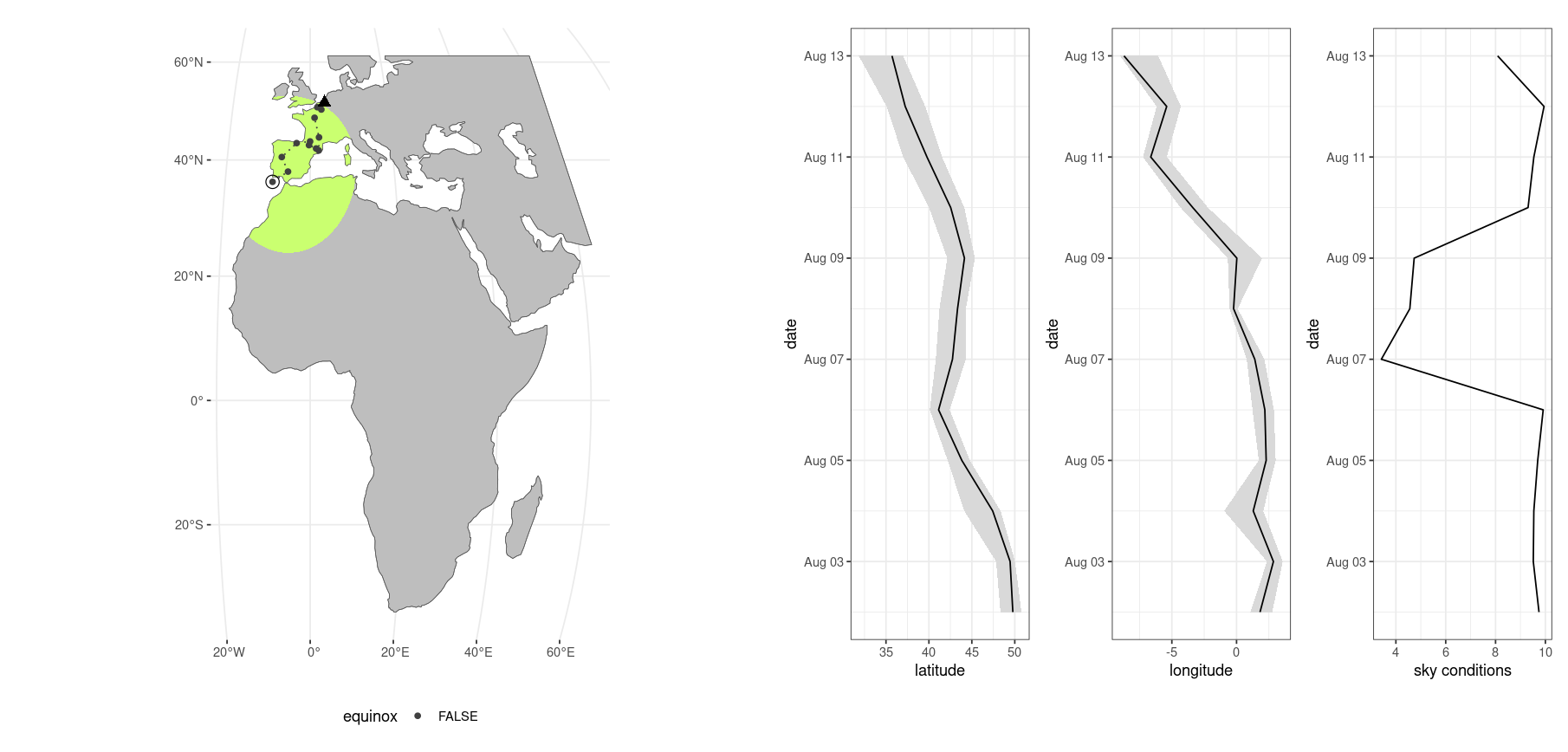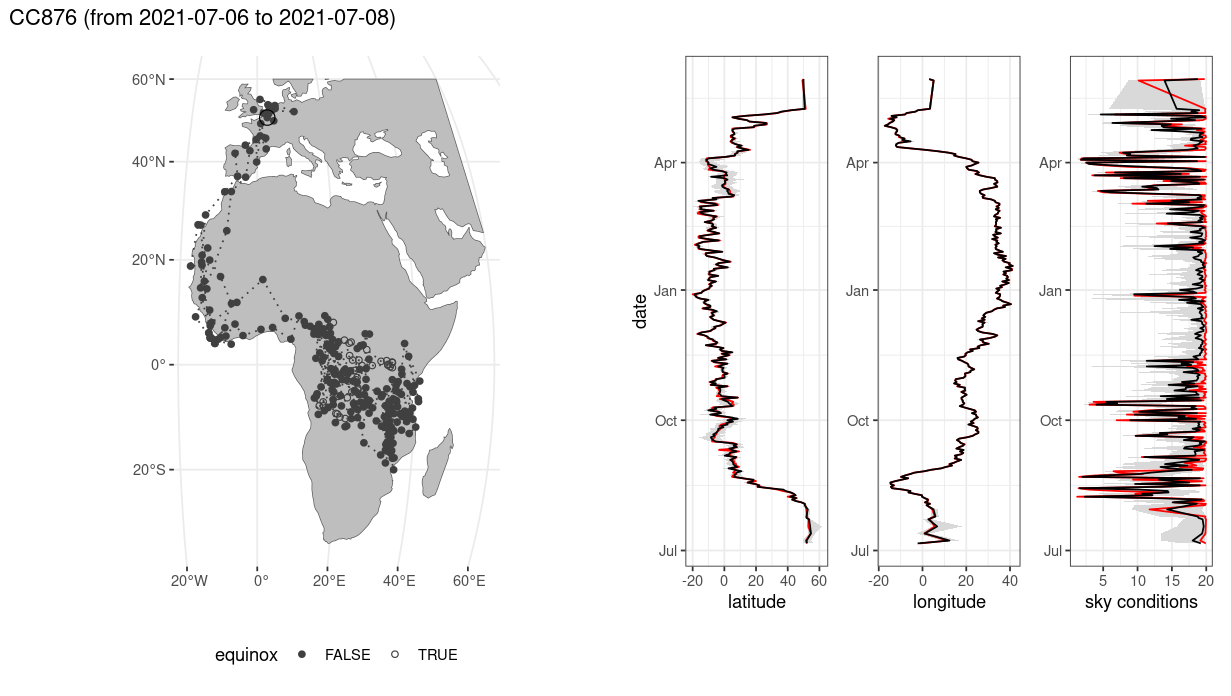The routine uses model optimization and parameter estimation to determine locations robustly using a template matching approach and behaviourally informed constraints. For now, {skytrackr} focuses on western European flyways and might not work beyond this area.
How to cite this package
You can cite this package like this “we obtained location estimates using the {skytrackr} R package (Hufkens 2023)”. Here is the full bibliographic reference to include in your reference list (don’t forget to update the ‘last accessed’ date):
Hufkens, K. (2023). skytrackr: a sky illuminance location tracker. Zenodo. https://doi.org/10.5281/zenodo.8331492.
Installation
stable release
To install the current stable release use a CRAN repository:
install.packages("skytrackr")
library("skytrackr")development release
To install the development releases of the package run the following commands:
if(!require(remotes)){install.packages("remotes")}
remotes::install_github("bluegreen-labs/skytrackr")
library("skytrackr")Vignettes are not rendered by default, if you want to include additional documentation please use:
if(!require(remotes)){install.packages("remotes")}
remotes::install_github("bluegreen-labs/skytrackr", build_vignettes = TRUE)
library("skytrackr")Use
To demonstrate the functioning of the package a small demo dataset of a couple of days of light logging of a Common swift near a nest box in Ghent, Belgium was included (i.e. tag cc876). I will use this data to demonstrate the features of the package. The package is friendly to the use of R piped (|>) commands. Using all default settings you can just pipe the data in to the skytrackr() function, while specifying only a mask, step-selection function and start location. The returned object will be a data frame containing the best estimate (median) of the longitude and latitude as well as 5-95% quantile as sampled from the posterior parameter distribution.
Data pre-screening
During the breeding season it is advised to remove data which is affected by time spent on a nest, altering the light signal and position estimates. Both the light patterns and other sensory data can be used to restrict the data to migration and non-breeding movements.
In the package I include the stk_profile() function which plots .lux files (and their ancillary .deg data) in an overview plot. The default plot is a static plot, however calling the function using the plotly = TRUE argument will render a dynamic plot on which you can zoom and which provides a tooltip showing the data values (including the date / time).
# read in the lux file, if a matching .deg
# file is found it is integrated into one
# long oriented data format
# (here the internal demo data is used)
df <- stk_read_lux(
system.file("extdata/cc876.lux", package="skytrackr")
)
# plot the data as a static plot
stk_profile(df)
# plot the data using plotly
# (this allows exploring data values, e.g. zooming in and using a tooltip)
stk_profile(df, plotly = TRUE)
Date and time values of the non-breeding season can easily be determined and used in further sub-setting of the data for final processing. You can use the automated stk_screen_twl() function to remove dates with either stationary roosting behaviour (with dark values during daytime hours), or with “false” twilight events (due to birds roosting in dark conditions).
# filter data using twilight heuristics
# and filter out the flagged values
df <- df |>
stk_screen_twl(filter = TRUE)
# you can run the stk_profile() command again
# to show the trimmed data, note all functions
# are pipeable
df |> stk_profile()
Further sub-setting can be done from this point, but if a bird is known to remain in a single location for breeding one can assume the individual is stationary. The filtering is there to provide as much of a hands-off approach as possible, but use expert judgement.
Basic optimization
To track movements by light using {skytrackr} you will need a few additional parameters. First, you will need to define the methodology used to find an optimal solution. The underlying BayesianTools package used in optimization allows for the specification of optimization techniques using the ‘control’ statement. The same argument can be used in the main skytrackr() routine.
In addition, care should be taken to specify the start location and tolerance (maximum degrees covered in a single flight - in km). The routine also needs you to specify an applicable land mask for land bound species. This land mask can be buffered extending somewhat offshore if desired. Finally, there is a behavioural component to the optimization routine used through the use of a step-selection function. This step-selection function determines the probability that a certain distance is covered based upon a probability density distribution provided by the user. Common distributions within movement ecology are for example a gamma or weibull distribution. Ideally these distributions are fit to previously collected data (either light-logger or GPS based), or based on common sense.
# define land mask with a bounding box
# and an off-shore buffer (in km), in addition
# you can specifiy the resolution of the resulting raster
mask <- stk_mask(
bbox = c(-20, -40, 60, 60), #xmin, ymin, xmax, ymax
buffer = 150, # in km
resolution = 0.5 # map grid in degrees
)
# define a step selection distribution/function
ssf <- function(x, shape = 0.9, scale = 100, tolerance = 1500){
norm <- sum(stats::dgamma(1:tolerance, shape = shape, scale = scale))
prob <- stats::dgamma(x, shape = shape, scale = scale) / norm
}In addition, the range of the scale parameter determines the range of light loss due to environmental conditions. This parameter needs to be set to for each sensor in order to reflect real world conditions. For Migrate Technology Ltd. sensors, or all those which track true light levels (in lux) reasonably well, you can use the stk_calibrate() function to estimate the upper scale parameter. For more details on these optimization settings I refer to the optimization vignette. Note that this function does not work for truncated profiles where light levels saturate above a certain level (this includes Migrate Technology Ltd. sensors which are configured as such).
scale_range <- data |> stk_calibrate()The package also provides two underlying light models, the default “diurnal” model assumes quasi-stationary. In short, for all calculated light values over a day only one latitude and longitude is used. The alternative “geodesic” mode calculated the locations along a greater circle path until the location of the final observed (selected) value in this diurnal cycle. The geodesic model therefore compensates for contractions or elongation of twilight events due to rapid movements (mostly east-west). The geodesic mode increases the calculation burden and influences both the speed of the processing as well as the accuracy (i.e. an increased number of iterations is required).
All these factors, the tolerance (maximum distance covered), the land mask (limiting locations to those over land), the underlying light model, and step-selection function (providing a probabilistic constrained on distance covered), constrain the parameter fit. This ensures stability of results on a pseudo-mechanistic basis.
locations <- data |>
skytrackr(
start_location = c(51.08, 3.73),
tolerance = 2000, # in km
scale = scale_range,
range = c(0.09, 148),
control = list(
sampler = 'DEzs',
settings = list(
burnin = 1000,
iterations = 3000,
message = FALSE
)
),
step_selection = ssf,
mask = mask,
plot = TRUE
)If you enable plotting during the optimization routine a plot will be drawn with each new location which is determined. The plot shows a map covering the geographic extent as set by the mask you provide and a green region of interest defined by the intersection of the mask and a hard distance threshold tolerance (tolerance parameter). The start position is indicated with a black triangle, the latest position is defined by a closed and open circle combined.
During equinoxes the small closed circles will be small open circles as these periods have increased inherent uncertainty. To the right are also four panels showing the best value of the three estimated parameters as a black line, and their uncertainty intervals. In addition, the Gelman-Rubin Diagnostic is shown, with values below 1.2 showing convergence of the location (parameter) estimates. Note that using the plotting option considerably slows down overall calculation due to rendering times (it is fun and informative to watch though, consider using it on a single individual to establish the optimization settings).

You can map the final location estimates using the same rendering layout using stk_map().
locations |> stk_map()
Batch processing
The {skytrackr} package follows/supports tidy data processing logic. Simple serial batch processing of individual loggers is supported by using the dplyr::group_by() function, and wrapping the function call in a dplyr::do() statement. For more complex, parallel, data processing I refer to the parallel processing vignette.
locations <- data |>
group_by(logger) |>
do({
skytrackr(
.,
start_location = c(51.08, 3.73),
tolerance = 2000, # in km
scale = c(1, 50),
range = c(0.09, 148),
control = list(
sampler = 'DEzs',
settings = list(
burnin = 1000,
iterations = 3000,
message = FALSE
)
),
step_selection = ssf,
mask = mask,
plot = TRUE
)
})Reasonable expectations and limitations
{skytrackr} currently mostly focuses on western European flyways, or those without a strong longitudinal component, and might not work beyond this area. Although “quasi” calibration free, it balances parameter optimization between the location to be estimated, the light loss (sky condition), the path covered, and the step selection function (and is further constraint by land mass if so desired).
In this context, and as described in the vignette, optimization success depends on the physical accuracy of these constraints and a reasonable understanding of the ecology of your species of interest. As with any optimization method used in location estimation there will be variation between optimization runs (unless a random seed is set), and is in part art as well as science.
It is worth mentioning that there is a serial dependency during location estimation. Although, “runaway” estimates the temporal dependency is theoretically limited to the previous step, there might still be a chance of errors propagating. The latter also puts into context that poor quality data might not only affect the estimation of the location of a single diurnal cycle.

